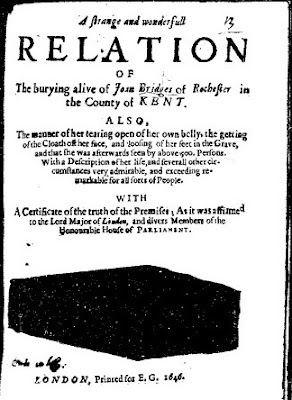
It is hard, off hand, to think of many cultures as ill-served by their medicine men as early modern
In a line of morbid reading, I have been following up a horror which sometimes followed on from amateur misdiagnosis, that is, the cases of premature burial recorded in 17th century pamphlets. In writing about the case of Anne Greene
http://roy25booth.blogspot.com/2007/05/two-versions-of-wonder.html
I did not mention the awful addition at the end of one of the pamphlets about her case (after being hanged, Greene was in her coffin and about to be dissected when she was heard to be alive and making noises). To his account, the writer “annexed another strange wonder from Ashburn in Darbishire, shewing how a young woman dying in child-bed, was buried, and delivered of a young son in the grave”.
(In: A declaration from Oxford, of Anne Green a young woman that was lately, and unjustly hanged in the Castle-yard, 1651).
This appalling anecdote has stayed with me since I read it. I do not believe that post-mortem parturition is possible (I am not minded to try any research about that), but the baby was heard crying in the grave, and had died before the exhumation of his unfortunate mother. ‘We come to seek a grave…’
http://www.upword.com/donne/deaths-duel.html
Laurence Cawthorn was a young butcher, an epileptic and a drinker, who after the 17th century version of a late night (ending before 10pm), during which he had drunk a quart of ‘hot waters’, asked to be woken at the 17th century version of early, that is at 3am, as he had slaughterman’s work to do ahead of the succeeding market day (Friday, June 21st). But banging on his door had no effect, by
During the weekend after his burial (one pamphlet says it was on Sunday, the other, Saturday) poor Cawthorn regained consciousness in the grave. His coffin was just a yard below the surface, and ‘lamentable Screeks, sad crys and a rumbling noise’ could be heard from beneath the ground. A crowd gathered, and ‘some of them spoke to the Sexton to dig up the Grave’, but he told them he could not do so without authorisation. All Sunday night the local residents could hear continued ‘sad groans’.
Finally the grave was re-opened on Monday. Cawthorn was dead by then. He hadn’t just asphyxiated, in his traumatic struggle, demented by terror, he had ‘beaten himself to Death in the Coffin’. The first pamphlet was either written or even in print by the Tuesday:
An Exact relation of the barbarous murder committed on Lawrence Corddel a butcher who was buryed alive at Christ Church on Fryday last ... with lamentable screeks, groans, and horrid cryes made by him in his grave on Sunday night, and the sad, wounded, and mortify'd condition he was taken up in on Munday, June 24 : as also the examination and confession of his land-lord and land-lady ... before the Right Honorable the Lord Mayor of London by whom they were both committed to New-gate(1661).
Later, but still before the hearing, the other pamphlet appeared. ‘Murder’ has become ‘accident’, but the landlady is still seen as culpable. (Somebody had to be.)
The Most lamentable and deplorable accident which on Friday last, June 22, befell Laurence Cawthorn, a buccher in St. Nicholas Shambles in Newgate Market who being suspected to be dead by the two hasty covetousness and cruelty of his land-lady ... was suddenly and inhumanely buryed : together with the report of his moving of the body as it was carrying by the bearers to his grave, and the treating of his winding sheet with his own hands, and the lamentable shrieks and groans he made on the Saturday and Sunday following : as also the examination and commitment of his land-lord and land-lady by the lord mayor to the prison of Newgate (1661).
The case of Joan Bridges was just as frightful. She was a woman of a reasonably good reputation, who worked for a baker, but she was another drinker, and one morning after a drinking session in a
A strange and wonderfull relation of the burying alive of Joan Bridges of
‘The muffler which was tyed about her face was rubbed off, her nose by the low roof of her prison house was beat flat with her cheeks, the strings which tyed her toes together had torn the skin from the bone…’ The rest of it is worse. I suppose a dead person’s toes were (are?) tied together for ease of handling.
My image features the fantastically minimalist woodcut executed for the Joan Bridges pamphlet.
You know, that's going to stay with me for a long time. That truly is horrible. I can understand why people get cremated.
ReplyDeleteIt's a pretty unambiguous title-page colophon, there, isn't it.
ReplyDeleteOn the other hand, I've often thought the fear of being buried alive is actually the transference of a simpler, more basic fear: of being dead. Death, after all, is the box from which, no matter how we scrabble and shout, we cannot escape.
The comforting idea with death, though, is presumably that you don't know you're dead. One hopes that we don't suffer after death as one would suffer being buried alive, ie. that you're not there going, "Help! I'm dead! This is rubbish! Bring me back to life!" Death is only frightening whilst we're still alive.
ReplyDeleteDecidedly B.: you're right, of course that being dead won't bother us when we're dead. But as you point out it can bother us now, and that's what these stories are about.
ReplyDeleteI'm still horrified by the sexton refusing to re-open the grave. The great British workman! - 'Nothing to do with me ... more than my job's worth... alright when I left it'.
ReplyDelete